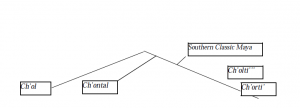Craig M. Warren and Dr. John Robertson, Linguistics
Perhaps one of the greatest achievements of the Mayan Civilization was their development of a writing system. Remnants of this highly sophisticated writing system can be found beautifully etched on temples and other ancient structures scattered throughout parts of Southern Mexico and Central America.
Much of these ancient hieroglyphs have yet to be completely deciphered, as it has been unclear from which language family they proceeded. However, recent decipherments point to the Ch’olan subgroup of Mayan, and specifically the eastern branch of Ch’olan. Embodying the eastern branch of Ch’olan are two languages, Ch’olti’, a now an extinct language and Ch’orti’, which is still spoken in parts of Chiquimula Guatemala.
While today many epigraphers are of the opinion that Ch’orti’ speakers are the living descendants of the hieroglyph writers, some controversy surrounds the relationship between the two languages. Studies at Rafael Landivar University have concluded that Ch’olti’ and Ch’orti’ hold a “sister type” relationship, as seen in Figure 1
Dr. John Robertson, chair of the Linguistics Department at BYU, and Dr. Stephen Houston,
Department of Anthropology, sharply contend that Ch’orti’ is a direct descendant language of
Ch’olti and Southern Classic Maya (the language of the hieroglyphs). See Figure 2
To further support their claim, we initiated the compilation of a Ch’orti’ dictionary. To accomplish this, Pantaleon Garcia Ramos, a native Ch’orti’ speaker from Jocotan, Chiquimula was flown in to help create a Ch’orti’ Dictionary. Mr. Ramos and I created a small dictionary which was then combined with existing information and organized into a computer format.
The actual organization of information proved to be the toughest part surrounding research. Software compatibility problems complicated an otherwise straightforward task though once accomplished, it proved to be an effective way to match up Ch’olti’/Ch’orti’ cognates.
The final results unveiled a great number of words consistent to both languages. These similarities and cognates seem to bolster the claim that Ch’orti’ actually descended from Ch’olti’. These results when combined with the results of previously conducted research on a vowel shift (by Dr. John Robertson) have me convinced the Father-Son relationship that exists between the two languages.
While I feel satisfied with what the research has produced, much has been left to explore in the future. Working to prove this link between Southern Classic Maya and a living language have been the most exciting part in this project and will be the fuel that motivates further study.


